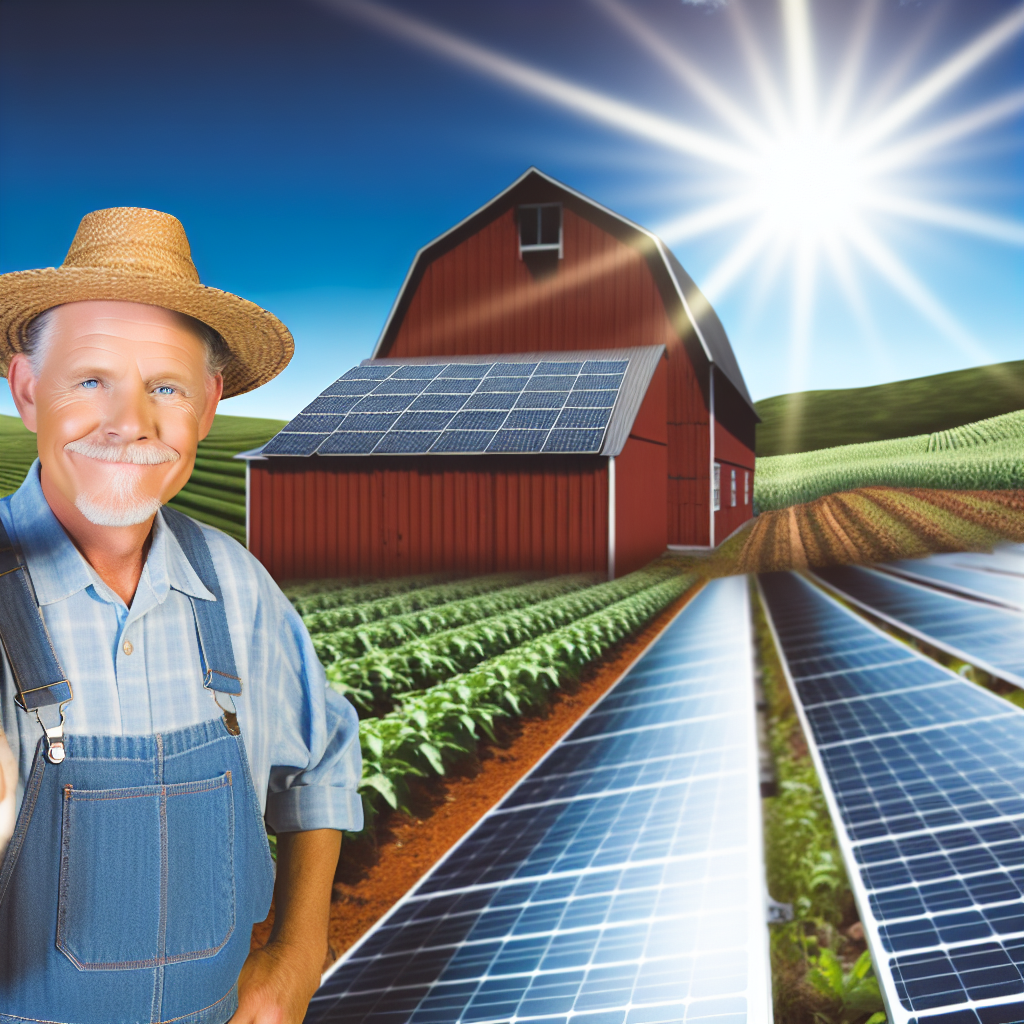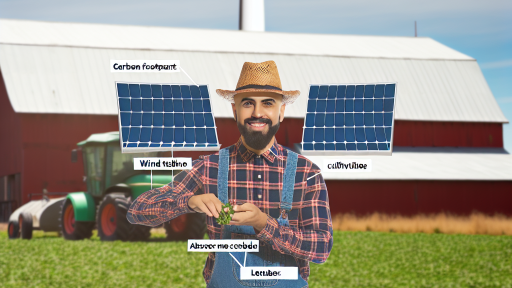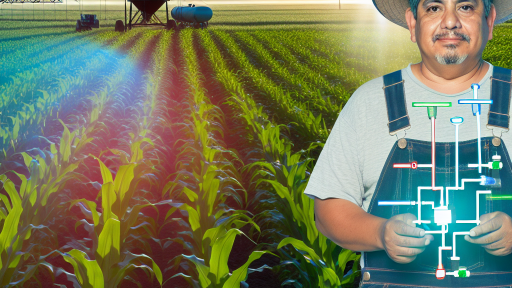Overview of Renewable Energy in Agriculture
Defining Renewable Energy
Renewable energy comes from sources that naturally replenish.
These include sunlight, wind, and water.
Farmers increasingly use these resources for energy.
The Role of Renewable Energy in Modern Farming
Modern farms face energy challenges daily.
Renewable energy provides sustainable solutions.
It reduces reliance on fossil fuels and lowers costs.
Types of Renewable Energy Used in Farming
Solar energy is one of the most popular choices.
Farmers can install solar panels on rooftops or fields.
Wind energy becomes another viable option.
Wind turbines can generate electricity for farming operations.
Hydropower also supports irrigation and energy needs.
Benefits of Using Renewable Energy
First, renewable energy enhances energy security.
Farmers can produce their own energy, reducing costs.
Second, it promotes environmental sustainability.
Using clean energy helps decrease greenhouse gas emissions.
Transform Your Agribusiness
Unlock your farm's potential with expert advice tailored to your needs. Get actionable steps that drive real results.
Get StartedThird, it can lead to government incentives.
Many programs offer financial support for renewable projects.
Challenges and Considerations
Transitioning to renewable energy involves initial costs.
However, many farmers find the long-term savings worthwhile.
Moreover, understanding local regulations is essential.
Farmers must navigate permits and incentives effectively.
Future Prospects of Renewable Energy in Agriculture
The future looks promising for renewable energy in farming.
As technology advances, energy efficiency improves.
Farmers will continue to adopt these innovative solutions.
Ultimately, this shift fosters a resilient agriculture sector.
Cost Savings through Renewable Energy Adoption
Initial Investment and Long-Term Savings
Farmers experience upfront costs when investing in renewable energy systems.
However, these costs often decrease significantly over time.
This results in substantial savings on energy bills for farmers.
Renewable systems like solar panels and wind turbines often provide free energy once installed.
Consequently, farmers can allocate resources to other critical areas.
Government Incentives and Grants
Many governments offer incentives to encourage renewable energy adoption.
These can include tax credits, rebates, and grants.
Such financial assistance can dramatically reduce initial investment costs.
Farmers should research available programs in their region.
Utilizing these incentives boosts the economic viability of renewable projects.
Reduced Operating Costs
Renewable energy systems lower operating costs compared to traditional energy sources.
They eliminate fluctuating energy prices commonly associated with fossil fuels.
Farmers can better predict their energy expenses each month.
This predictability aids in budgeting and financial planning.
Showcase Your Farming Business
Publish your professional farming services profile on our blog for a one-time fee of $200 and reach a dedicated audience of farmers and agribusiness owners.
Publish Your ProfileMoreover, decreased dependence on external energy sources increases farm resilience.
Environmental Benefits Leading to Financial Gains
Adopting renewable energy also improves environmental conditions.
Farmers contribute less carbon emissions, positively impacting local ecosystems.
This action can attract eco-conscious consumers and premium pricing.
As a result, a sustainable farming image can lead to increased marketability.
In turn, this boosts profits and enhances consumer loyalty.
Investment in New Technologies
Renewable energy adoption often encourages innovation on farms.
Farmers integrating these technologies can achieve greater efficiency.
For instance, automated irrigation systems can optimize water use.
Consequently, efficient operations lead to reduced energy consumption.
This ultimately contributes to further cost savings over time.
Environmental Impact of Renewable Energy on Farming
Reduction of Greenhouse Gas Emissions
Renewable energy sources significantly decrease greenhouse gas emissions.
They replace fossil fuels commonly used on farms.
By shifting to solar and wind, farmers lower their carbon footprint.
This action mitigates climate change effects on agriculture.
Improved Air Quality
Transitioning to renewable energy improves air quality around farms.
Reducing reliance on diesel generators minimizes harmful pollutants.
This leads to healthier air for both crops and livestock.
Consequently, better air quality enhances farm productivity.
Conservation of Water Resources
Renewable energy technologies often require less water than traditional methods.
For instance, solar panels need minimal water for cleaning.
This conservation benefits farmers facing water scarcity challenges.
Overall, efficient use of water supports sustainable farming practices.
Biodiversity Preservation
Using renewable energy can help preserve local ecosystems.
By reducing pollution, it protects habitats from degradation.
As a result, biodiversity remains intact, benefiting agricultural resilience.
Farmers can rely on diverse species to promote healthy soils.
Sustainable Development and Economic Benefits
Renewable energy promotes sustainable development in rural areas.
This leads to job creation in green technologies.
Farmers can benefit from state and federal incentives for renewable projects.
Ultimately, this fosters a stronger, more resilient agricultural economy.
See Related Content: Climate Risks And Crop Yield Declines
Increased Energy Independence for Farmers
Understanding Energy Independence
Energy independence empowers farmers to produce their own energy.
This shift reduces reliance on external energy sources.
Consequently, farmers gain more control over their energy costs.
Implementation of Renewable Energy Sources
Farmers can utilize solar panels to harness sunlight.
In addition, wind turbines can generate energy from wind.
Both options offer sustainable solutions for energy needs.
Financial Savings and Benefits
Investing in renewable energy can lead to significant savings.
Farmers can reduce monthly energy bills over time.
Showcase Your Farming Business
Publish your professional farming services profile on our blog for a one-time fee of $200 and reach a dedicated audience of farmers and agribusiness owners.
Publish Your ProfileMoreover, government incentives may enhance funding for these projects.
Enhancing Farm Resilience
Energy independence strengthens a farm’s resilience against outages.
In case of emergencies, farmers can rely on their energy production.
This reliability ensures consistent farm operations year-round.
Environmental Advantages
Renewable energy sources promote sustainability on farms.
They help reduce carbon footprints and greenhouse gas emissions.
Furthermore, implementing solar and wind energy aligns with eco-friendly practices.
Delve into the Subject: Cover Crops and Their Role in Gas Mitigation
Technological Innovations in Renewable Energy Systems
Advancements in Solar Energy
Solar energy technology has significantly evolved in recent years.
Farmers now utilize advanced solar panels for efficient energy production.
These panels can be integrated into existing farm structures.
Moreover, tracking systems maximize sunlight exposure.
Wind Energy Solutions
Wind energy represents another valuable resource for farmers.
Modern wind turbines are smaller and more efficient than ever.
Farmers can install these turbines on their land to generate power.
This setup reduces dependency on traditional energy sources.
Biogas Production Technologies
Biogas technology provides a sustainable energy option for farming operations.
Farmers can convert waste materials into usable energy.
This process not only produces energy but also reduces waste disposal issues.
Ultimately, this leads to cost savings and environmental benefits.
Integration with Smart Farming
Smart farming technologies enhance renewable energy systems.
Farmers can monitor energy usage in real time through smart devices.
These innovations allow for better management of resources.
Efficient energy use directly impacts overall productivity.
Financial Incentives and Support
Government programs often support farmers’ use of renewable energy.
Financial incentives make technology investments more accessible.
Farmers can receive grants and tax breaks for green energy projects.
Such support promotes widespread adoption of renewable systems.
Explore Further: Building Resilient Farms Against Climate-Induced Floods

Enhancing Crop Yields with Renewable Energy Solutions
Utilizing Solar Power on Farms
Farmers can significantly boost crop yields by harnessing solar energy.
Solar panels provide a reliable energy source for irrigation systems.
Moreover, they reduce reliance on fossil fuels and decrease operational costs.
Consequently, farmers can allocate more funds to essential resources.
This results in a healthier environment and improved soil quality.
Implementing Wind Energy for Agricultural Efficiency
Wind energy is another renewable option that farmers can consider.
Wind turbines can power farm machinery and storage facilities.
This shift lowers energy costs and supports larger-scale operations.
Additionally, wind energy can enhance mechanization in farming practices.
As a result, farmers can manage land more efficiently.
Integrating Biomass Energy for Sustainable Practices
Biomass energy offers a sustainable alternative to traditional energy sources.
Showcase Your Farming Business
Publish your professional farming services profile on our blog for a one-time fee of $200 and reach a dedicated audience of farmers and agribusiness owners.
Publish Your ProfileFarmers can utilize waste materials to generate renewable energy.
This process reduces waste and creates useful energy for farm operations.
Furthermore, biomass can improve soil fertility when returned to the land.
Overall, it promotes a circular economy within farming systems.
Adopting Geothermal Energy for Consistent Growth
Geothermal energy provides an efficient heating solution for greenhouses.
This technology enables year-round crop production, irrespective of climate.
Additionally, it reduces the need for external heating sources.
Consequently, farmers can invest savings into other growth opportunities.
Ultimately, geothermal energy contributes to stable yield enhancements.
Accessing Government Incentives and Support
Governments often offer incentives for renewable energy adoption in agriculture.
Farmers should research available grants and loan programs.
These resources can help offset initial costs associated with renewable technologies.
Moreover, participating in these programs supports sustainable farming initiatives.
Thus, farmers can achieve long-term economic and environmental benefits.
Find Out More: Adapting Agriculture to Climate Change Effectively
Government Incentives and Support for Renewable Energy Investments
Understanding Government Incentives
Governments offer various incentives for renewable energy investments.
These incentives may include tax credits and rebates.
In addition, grants and low-interest loans support farmers transitioning to renewable energy.
Furthermore, many states provide specific programs for agricultural producers.
Types of Financial Support
Farmers can benefit from federal programs aimed at renewable energy integration.
The Rural Energy for America Program (REAP) is a popular federal initiative.
This program provides grants and loan guarantees for energy efficiency improvements.
Furthermore, the USDA also offers assistance with solar and wind energy projects.
State-Level Programs
Many states have their own incentive programs for renewable energy investments.
For example, California provides significant rebates for solar installations.
Similarly, states like Texas and Colorado have unique tax incentives.
These programs often vary widely, so farmers should research local options.
Supporting Resources
Farmers can access numerous resources to help them navigate incentives.
Both government websites and agricultural extension services offer guidance.
Additionally, organizations like the American Farm Bureau provide useful insights.
Networking with local farmers can also prove beneficial for information sharing.
The Long-Term Benefits
Investing in renewable energy reduces long-term operational costs.
By harnessing natural resources, farmers can lower their utility expenses.
Moreover, sustainable practices enhance farm resilience against climate change.
Consequently, these investments contribute to a more sustainable future for agriculture.
Case Studies: Successful Implementation of Renewable Energy in Farming
Solar Energy for Crop Irrigation
Sunny Acres Farm in California successfully adopted solar energy for irrigation.
This transition significantly reduced their energy costs.
They installed solar panels that powered their pumps efficiently.
As a result, they experience less dependency on fossil fuels.
Additionally, they have a reduced carbon footprint.
Showcase Your Farming Business
Publish your professional farming services profile on our blog for a one-time fee of $200 and reach a dedicated audience of farmers and agribusiness owners.
Publish Your ProfileThe farm reported a 30% savings on their energy expenses.
Wind Energy for Grain Drying
Greenway Farms in Texas implemented wind turbines for grain drying.
These turbines generate consistent electricity year-round.
In fact, the process accelerated drying times significantly.
Farmers now have more control over their harvest schedules.
They also lowered their reliance on grid electricity.
This shift has led to enhanced operational efficiency.
Biogas Production from Livestock Waste
Riverside Farm in Ohio transformed animal waste into biogas energy.
They installed a biogas digester that converts waste into usable energy.
This innovation helps power their facilities and equipment.
Moreover, they have reduced waste disposal costs significantly.
The process also generates valuable compost for their crops.
This holistic approach supports both energy needs and soil health.
Integrating Renewable Energy in Organic Farming
Sunshine Valley Organic Farm in Oregon embraced a combination of renewables.
They utilize solar panels and wind turbines for their energy needs.
This integration supports their commitment to sustainable practices.
Farmers report improved crop yields due to better energy management.
Furthermore, the approach attracts environmentally conscious consumers.
The farm serves as a model for others in the organic sector.
Additional Resources
Environmental Impacts of Wind Power | Union of Concerned Scientists




